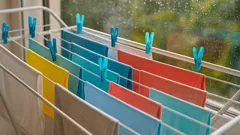
Drying laundry during the rainy season in the Philippines can be a real challenge. Often, even the slightest hint of sunshine isn't enough—and then a pile of wet clothes starts to smell like kulob. Today, you’ll discover a simple Japanese washing method that helps your clothes dry faster and stay fresher no matter what the weather is like. Want to learn this secret? Find out more about this clever trick that has saved many Pinoy households from the hassle of waiting for wet laundry to dry.
Understanding the Humidity Problem in the Philippines
Here in the Philippines, we’re no strangers to extreme humidity. During tag-ulan, humidity can reach up to 85 percent, making it extra difficult to air-dry laundry. If clothes stay in the laundry area the whole day, they can end up smelling musty. Since most homes don’t have dryers, we rely on the weather and practical strategies. Now, let’s take a look at the Japanese approach trusted for solving this problem.

The Japanese Laundry Drying Method Revealed
The Japanese always look for ways to maximize efficiency. Their laundry hack uses smart techniques—like spreading clothes further apart, grouping similar thickness together, and using electronic fans or keeping windows open. They even place delicate items in the middle and thicker ones at the edges so air flows evenly around each piece of clothing. The hanger isn’t just for hanging—placement and airflow matter, too.
Step-by-Step Guide for Faster Drying
- Space clothes correctly —Don’t let your clothes touch each other. Giving them room is key for fast drying.
- Sort according to thickness —Hang thicker items on the edges and lighter ones in the middle to ensure optimal drying.
- Utilize an electric fan —Place clothes near a fan for more air movement, which helps them dry faster.
- Make sure there is adequate ventilation —Open a window a bit to let humid air out, while keeping a fan on for constant airflow.
Did you know? Clothes can dry 30 percent faster when spaced out properly and with good air movement, even without sunlight.
Why This Works for Filipino Homes
Most Pinoy households don’t have dryers, so using an electric fan and proper spacing is both cost-effective and efficient. This method also prevents mold growth and the dreaded "amoy kulob" by making sure there’s no trapped air between fabrics. The next time it rains for days, you’ll be ready. No more semi-dry uniforms or running around looking for a dry towel!
Extra Pro Tips for the Rainy Season
- Rotate hangers every few hours so all sides of the fabric get exposed to air.
- Roll wet clothes in a clean dry towel before hanging to reduce moisture.
- Use clips to hang socks or small items—this saves space and ensures even exposure to air.
It’s amazing how a small change—like using the Japanese laundry method—can transform laundry day. By organizing your drying racks thoughtfully, using your electric fan, and making sure you have good ventilation, drying clothes during the wet season becomes much easier. Want more smart laundry tips that Filipinos swear by? Discover these methods so you can finally say goodbye to "amoy kulob" forever.
 Meg Magazine
Meg Magazine



Comments